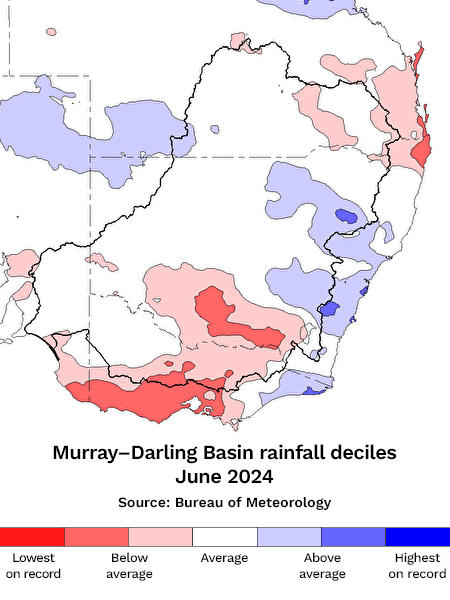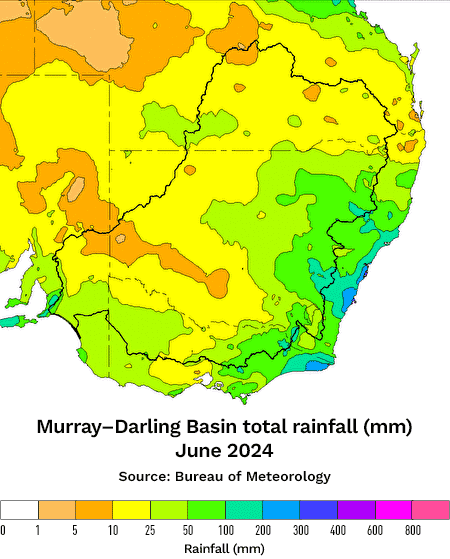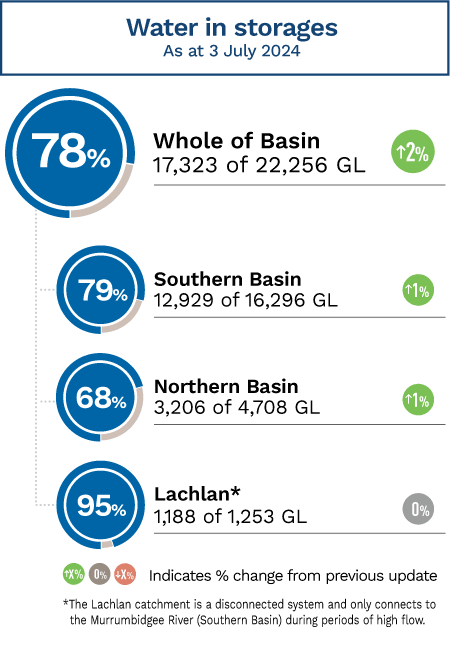Please be advised this will be the final edition of Basin in Brief for 2024. If you’d like to continue receiving regular updates on the Basin, please subscribe to our newsletter.
- Below average June rainfall for much of the Basin
- The Bureau continues to forecast dry conditions as we move through winter
- Conditions remain favourable for blue-green.

Drought
A trend in dry conditions continues throughout the Basin, as predicted in the State of the Climate 2022 report. These conditions are largely evident in the south-east of Australia.
Rainfall was below to very much below average (in the lowest 10% of Junes since 1900) for most of Victoria, parts of southern and far north-east New South Wales, south-eastern and northern parts of Queensland and isolated pockets of southern South Australia.
Despite this drier picture for most of the Basin, eastern parts of New South Wales recorded above average to very much above average rainfall for June.
Soil moisture deficiencies increased along the south-east corner of South Australia, across much of Victoria and areas of southern New South Wales. Small areas of lowest on record soil moisture for this time of year (based on all years since 1911) have developed along the coastal fringe of south-east South Australia and western Victoria.

Rainfall
Across the Basin, the Bureau reported an area-average rainfall totalling 28.5 mm, which is 6% below the long-term June average.
In the northern Basin it was Gowrie in the Namoi catchment that topped the chart for rainfall, receiving 135mm.
Highest rainfall for the southern Basin was recorded in the Snowy Mountains of New South Wales, with 230mm at Perisher Valley.
Scattered areas of both the northern and southern Basins were significantly drier than the rest of the system, with some locations recording less than 1mm for the month of June.

Water storages and streamflow
As of 3 July 2024, total storage in the Basin was 17,323 GL (78%), which is a 2% increase from June. Both northern and southern Basin storages increased by 1%, while the Lachlan catchment remained steady at 95%.
With the irrigation season now ended, releases for operational purposes have been wound back to minimums whilst flows continue to be supported by tributary inflows and use of water for the environment.
River Murray system inflows for June (excluding Snowy, Darling, IVT and environmental inflows) were 182 GL, which is well below the long-term average for June.
In the northern Basin, additional inflows are travelling down the Barwon-Darling towards the Menindee Lakes. In their latest update, WaterNSW have indicated that a further 30 to 70 GL may arrive at the lakes in the coming months.
Releases are being made from Hume Dam in order to maintain lake levels at Yarrawonga and initiate refilling via tributary inflows as much as possible.
Downstream on the River Murray at Wentworth Weir, the water released from Lake Wetherell as part of the connectivity trial has now passed through Lock 10 and is making its way downstream, with a noticeable change in colour evident.
The Tar-Ru storage volume is being managed in accordance with the Lake Victoria Operating Strategy (LVOS) as specified in the Objectives and Outcomes for River Operations in the River Murray System. It is expected that by the end of May there will be no need to transfer additional water to Tar-Ru, and the MDBA does not anticipate calling any additional water from the Menindee Lakes for the remainder of the water year.
The flow to South Australia is expected to increase over the coming weeks as the Goulburn winter fresh arrives at the border.
Climate outlook
The Bureau’s long-range forecast released on 4 July 2024, indicates that for July to September, rainfall is likely (60 to 80% chance) to be above average for most of New South Wales, the southern half of Queensland, and northern South Australia.
Rainfall is likely to be within the typical range for the season for parts of far southern Australia, including most of Victoria.
Above average maximum temperatures are also likely to very likely (60% to greater than 80% chance) across most of Australia.

Water quality
The likelihood of water quality issues typically reduces across the cooler months. Conditions remain favourable for blue-green algae within many Basin waterbodies, with some areas still experiencing elevated salinity from earlier northern inflows.
Water quality within the Basin is monitored by individual States. Any site-specific alerts, warnings or advisories are issued by those respective States.
Summary of key water quality issues
- Blue-green algae: There remains an algal risk across much of the Basin, particularly at some key waterbodies in NSW and Victoria including the Menindee Lakes, lower Darling (Baaka) and Lake Eildon. SA continues to see elevated levels along the River Murray near the border, and in Lake Alexandrina.
- Elevated Salinity: Parts of the Menindee Lakes and the lower Darling (Baaka) continue to see elevated salinity levels. SA’s southern Coorong is also currently experiencing elevated salinity levels that are impactful to biodiversity.
For more information on water quality issues in your area, refer the relevant agency contacts on the Report water quality issues or fish deaths page.
You can find all the latest news in our Newsroom or by following our socials: Facebook, X (Twitter), LinkedIn.